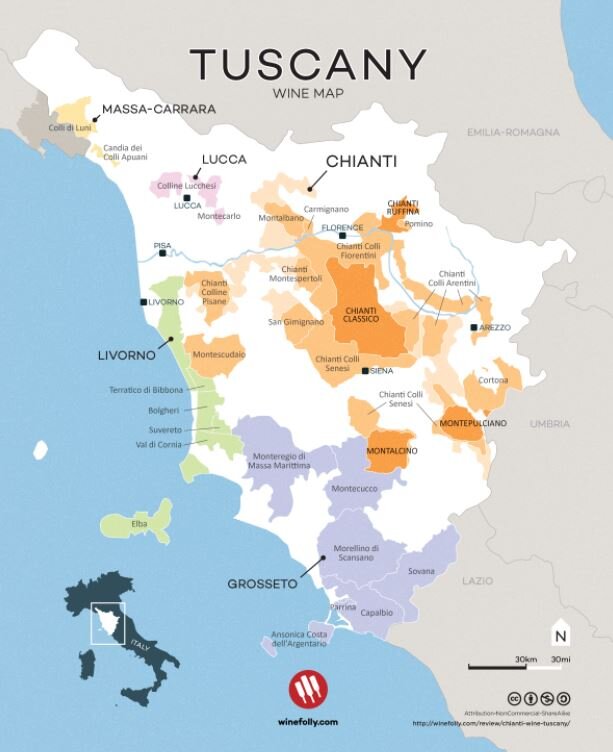Tuscany: Chianti and Beyond (Part 1)
by Erica MacKenzie
Where does the mind go when we hear the word “Tuscany”? For me, it’s winding medieval streets, Romanesque churches, renaissance art, cypress tree-dotted hillsides…and of course wine. Tuscan wine was my first memorable introduction to wine with a mini-bottle of Chianti Classico, traveling business class on Lufthansa en route to Florence for an internship where I was unexpectedly paid in food and wine. It was this decadent year abroad which cemented my love of wine and ultimately what brings me to write about one of my favorite subjects.
Wine has been produced in the Tuscan hills since the time of the Etruscans, as early as the 7th century B.C.E., making it an essential piece of the region’s identity. With its mild maritime climate (its right on the Mediterranean) the region has hot summers, cold, damp rainy winters, and a variety of microclimates. Tuscany is home to several world-renowned wine regions within its borders for a total of 41 DOC and 11 DOCG awarded wines. Short for Denominazione Origine Controllata, with its highest designation of DOCG to include Garantita (guarantee). This “Garantita'' requires the grape growth and wine processing be monitored and the wines taste-tested by approved tasters before labelling is allowed. Some of these well-known appellations include Brunello di Montalcino, Vino Nobile di Montepulciano, Morellino di Scansano, Vernaccia di San Gimignano, Bolgheri, Carmignano, Chianti and Chianti Classico to name just a few.
Red wines make up about 80% of the production from the region, so you can’t discuss Tuscan wine without talking about Sangiovese, a grape that, while prolific throughout much of Italy, seems to thrive best in Tuscany. This dark purple-skinned grape is known for its savory, flavorsome character, with notes of tomato, sour cherries, herbs, and clove, with generally firm tannins and conspicuous acidity providing structure. Numerous clones of this grape are recognized in Tuscany as well as across Italy which I’ll get to in a bit.
Like myself, the iconic wines of Chianti and Chianti Classico may have been your first taste of Sangiovese. These wines are justifiably famous, and have been regulated with wine laws reaching as far back as 1716. The just as in Bordeaux, the recipe has changed some over time; historic accounts say that Chianti started as a white wine in the 13th century, and that Colorino, a blending grape of the region, also played a bigger role. Whatever the truth may be, by 1872 the Premier of Italy, Baron Bettino Ricasoli, had created the official “chianti recipe”, making Sangiovese the star and relegating Colorino and Canaiolo to blending grapes. Maybe your first taste was from a squat bottle in a straw basket, informally referred to with great distaste as a “fiasco”, but times have changed with many quality wines produced now.
The Chianti and Chianti Classico wine regions span from Florence to Siena, with some production near Arezzo and Pisa. What’s the difference between these regions? First off, Chianti and Chianti Classico are separate wine producing regions, with Sangiovese the main player in all. In terms of location, Chianti Classico is the oldest demarcated wine region in Tuscany and centermost region of Chianti (dark orange on the above Wine Folly map) with all other Chianti subzones surrounding it. The wines labeled “Classico” must be made from at least 80% Sangiovese and cannot include any white grapes in the blend. For the less-restrictive “Chianti” only 70% needs to be Sangiovese.
So besides the difference in location, what sets Chianti Classico apart from the other Chianti designations? Charming hilltops aside, Chianti Classico's primary soils may be responsible. They are a mix of albarese (clay/limestone), galestro (schist/clay that is hard and compact), and sandstone. These types of hard, poor soils require that the vine struggle to find resources, which results in higher-quality grapes. As a result, Chianti as a wine is fresh, and best consumed young, whereas Chianti Classico is proven to have great ageing potential.
Chianti DOCG was formally divided into seven subzones in 1932: Rufina, Colli Aretini, Colli Fiorentini, Colli Senesi, Colline Pisane, and Montalbano. Montespertoli was added as an eighth in 1997. “Colli” means “hills” and is an illustrative indicator of the terrain. Of the 8 sub-zones, my favorite might be Rufina, its vivid fruit and structure due to its pronounced diurnal temperature shifts, higher elevation and slower-ripening Sangiovese. This region is further inland than most with a more continental climate and smaller production. Chianti Colli Senesi on the outskirts of Siena is another Chianti zone that I gravitate towards and always taste when I can. Parts of this region share elevation, soils and proximity with DOCG zones of Brunello and Vino Nobile, and have the alluring potential to make truly great wines.
There are some additional labeling designations to be aware of regarding production methods and aging requirements. Entry level wines are known as annata and must age for 12 months and obtain a minimum of 12% alcohol. Many wineries produce a Riserva wine in addition to their entry level. Riserva is aged an additional 12 months in barrel plus minimum three months in bottle to round out the flavors. The newest designation to look out for is Gran Selezione are estate-produced, single vineyard, 100% Sangiovese wines which must be aged a total of 30 months. It's wonderful to see winemakers continue to push their boundaries with the growing Gran Selezione category.
There is so much more to Tuscany than Chianti, which I’ll tell you about in Part 2 next week!


